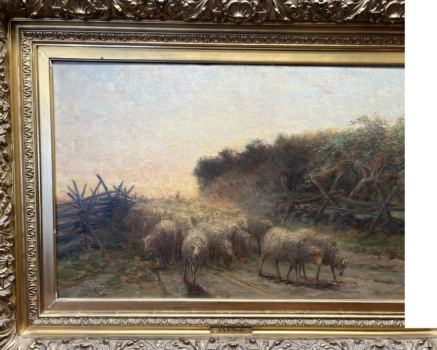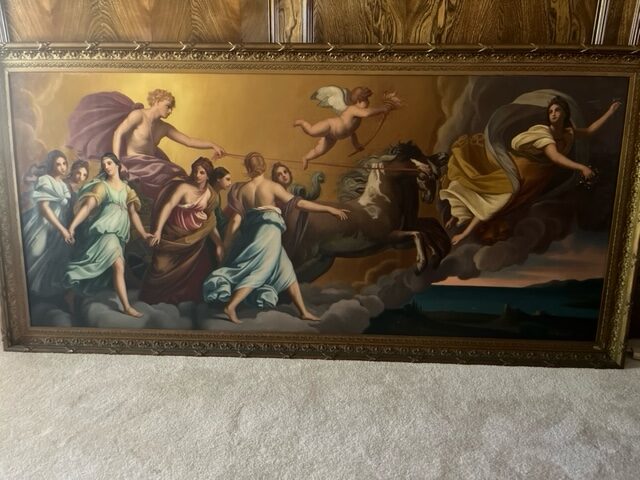This art appraisal report offers an in-depth and impartial assessment of the artwork in question, grounded in the appraiser’s expertise and familiarity with the art market. All the information and data analyzed in this report is sourced solely from the client.
Having a clear understanding of the value of your artwork is crucial in making informed decisions about its future. This report provides a precise estimate of the value of each piece, using US dollars as the base currency. It is not intended to encourage the sale of the artwork, but rather to provide valuable information on how to proceed should the client decide to do so in the future.
Detailed description of the artwork, including its medium, dimensions, and condition.
Checking Originality: Identification with Artificial Intelligence Test
In the quest to identify a match, Image Search employs advanced AI techniques to scour databases of images in order to find visually similar images. This is achieved through the use of various algorithms such as pattern recognition and machine learning. While some results may be considered as “matches” due to a clear similarity, other results may be inconclusive as they rely more on chance rather than any specific similarities. To conduct this test, a front-facing image was used as a reference to search for similar images on the internet.
The results of the automatic recognition are not conclusive. If a match is found, it will be shown below:
What specific information can we obtain from this test?
Our findings demonstrate this is a unique work of art; the comparison images in our gallery could not be matched with it. Even though there is always some uncertainty, we’ve found that this method gives accurate results 90% of the time, so it’s a good way to start figuring out if something is real. To completely identify the artwork, I continue to the next test.
Age estimation
Knowing the age of a painting, such as the An Original Painting by Listed Artist John Austin Sands Monks (1850-1917), can be done by looking at the frame construction, the color palette used, and other characteristics. The frame construction of a painting can be a good indication of the age of the piece. For example, in the case of the An Original Painting by Listed Artist John Austin Sands Monks, the frame is constructed of a hardwood that was a popular choice in the late 19th century and early 20th century. This indicates that the painting likely dates to around the time of the artist's life. Additionally, the colors used in the painting can be helpful in determining the age. For example, the use of bright colors and the pastel palette indicate that the painting was likely created closer to the first part of the 20th century. Finally, other characteristics of the painting may also be useful in determining its age. For instance, if the painting was signed and dated, that would be a clear indication of the age. In conclusion, the frame construction, color palette, and other characteristics can all be helpful in determining the age of a painting, such as the An Original Painting by Listed Artist John Austin Sands Monks.
Based on this information and the pictures provided, I can estimate this painting was made circa late 19th Century.
Condition of the artwork
This original painting by Listed Artist John Austin Sands Monks (1850-1917) is in great condition, with no restoration needed and minimal damage, if any. The painting appears to be in excellent condition, with no appreciable damages. It is a great example of Monks' work and a wonderful addition to any art collection.
Artist’s name, biographical information, artwork’s provenance (history of ownership) and exhibition history.
I study and research the signature of artwork to see if it matches any known signatures. At this step, I also inspect the painting’s front and back pictures, to find an artist’s name or other identifying features like stickers that may help me identify who has made this work. If there is any, provenance is also seen as an important variable because it helps figure out who the artist is.

A close picture of the signature is included in this report.
I can read the signature as:
JAS Monks
At this point, I can use the signature and try to find the artist’s name in a database of known-listed artists. Basically, it is a database with information about the names, surnames, origins, and biographies of the most well-known artists.
I found that the artist who painted this artwork is a listed and well known artist. JOHN AUSTIN SANDS MONKS Massachusetts/Illinois, 1850-1917.
John Austin Sands Monks (1850–1917) was an American painter and etcher known for his stunning paintings of sheep. Born in Cold Spring, New York, to John and Sarah Catherine Monks, he was educated at the Hudson River Institute and studied engraving under George N. Cass and painting under George Inness. Monks had a studio in Boston and was a member of the Boston Art Club, the Copley Society, the Salmagundi Club, and the New York Etching Club. His sister Sarah P. Monks was a naturalist. Monks had a long residency in Medfield, Massachusetts, and died in Chicago while visiting his daughter at the age of 66. He left behind a legacy of beautiful paintings of sheep that will be remembered for years to come.
Detailed analysis of the artwork’s style, subject matter, and significance within the artist’s oeuvre and the broader art world.
I can check if the style and type of painting match those of the artist referenced.
The painting by the listed artist John Austin Sands Monks (1850-1917) is characterized by an expressive and dynamic style. His brushstrokes are bold and confident, and his use of light and color create dynamic compositions full of movement. His use of form and texture is often quite intricate, giving his works a unique and detailed look. Monks' work often includes surreal and symbolic elements that bring a dream-like quality to his paintings. His unique style is characterized by its boldness, energy, and vivid imagery.
Comparable sales information, including prices realized at recent auctions or private sales of similar works by the artist or in the same medium.
In order to provide an up-to-date estimate of the fair market value for the original painting by listed artist John Austin Sands Monks (1850-1917), I utilized the data collected, including auction prices of similar works and other relevant market information. This is crucial as it can be used in various contexts such as insurance, estate planning, and art market analysis. It also offers a valuable insight into how the valuation of the artwork may have changed due to environmental or economic factors such as changes in demand for the artist's works or fluctuations in the art market prices.
The auction prices were a significant factor in determining the current market value of the artwork, as they are based on actual transactions between buyers and sellers in the art market. As such, they are a strong indicator of the expected value of the piece in the near future.
By analyzing auction results from the last 6 months, I was able to accurately determine the current fair market value of the artwork. This approach provides a comprehensive view of how the value has changed over time and gives insight into any potential areas of appreciation or depreciation in its price. Additionally, it allows me to adjust my valuation as new auction prices become available.
Conclusion
Investing in art can be a great idea for many reasons. Not only can art bring beauty and joy to a home, but it can also be a great financial investment. Artist's works can appreciate in value, making them a great asset to own. Buying a piece of artwork also gives you a unique item that you can show off to friends and family. Furthermore, artwork can be a great way to diversify an investment portfolio. Art can be a great alternative to more traditional investments, providing diversification and potential for appreciation. An original painting by a listed artist, such as John Austin Sands Monks (1850-1917), is particularly valuable and highly sought after due to the artist's fame and accomplishments. Buying a piece of artwork can be a great way to add beauty and value to a home or investment portfolio.
This painting can be considered valuable by the art market because John Austin Sands Monks was a listed artist who was popular and influential during his time. His artwork is highly sought after by art collectors, and the fact that this is an original painting makes it even more valuable. Additionally, due to the age of the painting, it can be considered a piece of art history, increasing its value even more.
Final Appraisal Value ($)
2,500-3,000$
Appraisal Report made by:
Andrés Gómez
BSc, MSc, Expert Art Appraiser
10+ years of experience in Online Art Appraisals
100k+ Customers Served
Antique Store Owner
You can check my portofolio of past appraisals here:
https://www.appraisily.com/andres-portofolio/

Relevant photographs or supporting documentation, such as condition reports or expert opinions
A detailed summary of the appraisal process and the appraiser’s qualifications.
Mark-to-market art appraisal is a vital method for determining the current value of a piece of artwork. This form of valuation requires an appraiser to consider various factors, such as market conditions, the condition and age of the artwork, and the artist’s reputation. By taking all these elements into account, a mark-to-market art appraisal delivers an accurate assessment of a piece of artwork’s current market value.
The artist’s reputation, as determined by their track record in gallery and museum shows, awards, and other accomplishments, is also considered in mark-to-market art appraisal. Appraisers use this information to determine if the value of a piece is likely to increase or decrease over time. Additionally, they will inspect the condition of the artwork and note any signs of wear or damage that might affect its future resale value.
When performing mark-to-market art appraisals, appraisers also consider market conditions by researching current art market trends and comparable works that have recently sold. This information is used to provide an estimate of a piece’s worth at that point in time. By considering all of these factors, mark-to-market art appraisal is able to give a reliable indication of the current value of a work. This kind of valuation can also ensure fair prices are paid and received when buying or selling art.
In summary, mark-to-market art appraisal is a crucial tool for determining the true value of a piece of artwork, enabling buyers, sellers, and appraisers to make informed decisions regarding its worth. It takes into account multiple aspects to provide an accurate assessment of the current market value of a work. This information can be used to ensure that buyers and sellers are getting a fair price for the artwork, and that the appraiser’s valuation is up-to-date and reflective of current market conditions.
In the case of insurance replacement appraisals, mark-to-market art appraisals can also be used to accurately estimate the cost of replacing a lost or damaged artwork. The current value, as determined by the appraisal, is then used to determine the amount that the insurance company will pay back to the policyholder. This way, policyholders can rest assured that they will receive an appropriate sum for any artwork that needs to be replaced due to accidental damage or theft. Additionally, this kind of valuation helps insurers ensure they are not being overcharged when artwork needs to be replaced as part of a claim settlement.
The appraisal process is a thorough evaluation of the item or items in question. It involves researching and analyzing the information provided by the requester in order to provide an accurate estimate of its value. The appraiser takes into account factors such as condition, rarity, demand, and market prices. Photographs and detailed descriptions are especially important when providing an appraisal, since they help the appraiser identify any potential flaws or defects that could affect the item’s worth. By using all the resources that are available, an evaluation can be done quickly, efficiently, and with a high level of accuracy.
A statement of the appraiser’s liability and any potential conflicts of interest.
A qualified art appraisal, also known as a formal written evaluation, is a professional assessment of the monetary value of a piece of art by an individual who has specialized knowledge, expertise, and training in the field of art appraisal. This person must meet certain educational and professional requirements, including experience in researching and evaluating art, as well as knowledge of the art market and current market trends. The purpose of a qualified art appraisal is to provide an objective and unbiased opinion of the value of a piece of art for various purposes, including insurance claims, tax planning, estate planning, or to help determine a fair price for a sale or purchase.
We are committed to providing our clients with the most accurate and unbiased appraisal reports. To ensure impartiality, we adopt a flat rate, fixed fee structure for all appraisals, instead of a percentage-based fee. This eliminates any potential conflicts of interest between the art appraiser and the final report value. Our appraisal reports are in compliance with the Appraisal Foundation’s USPAP (Uniform Standards of Professional Appraisal Practice) standards and guidelines, which are widely accepted as the ethical and performance standards for appraisers. This guarantees that our reports are of high quality and legally defensible.
How to sell this artwork.
We have a structured guide to help you sell your artwork, you can find it here.






